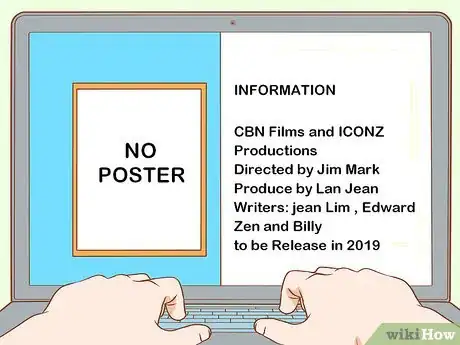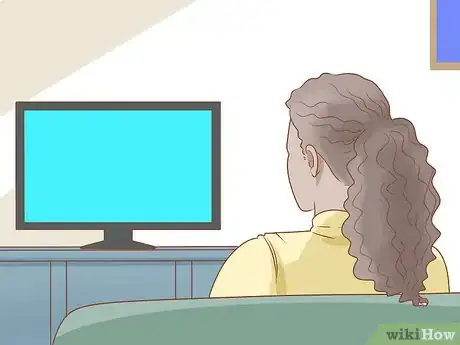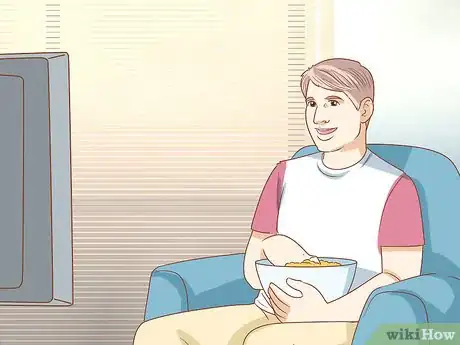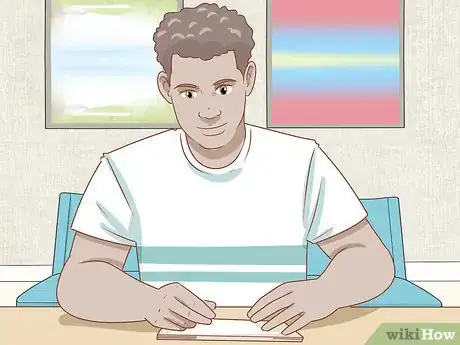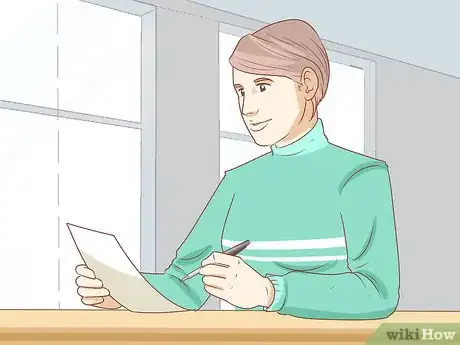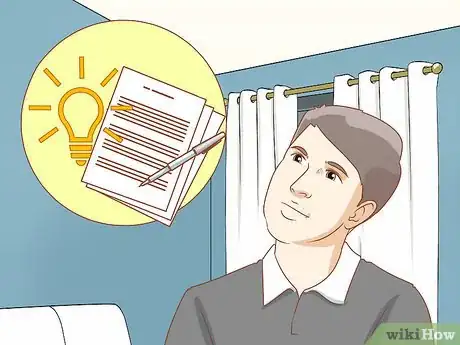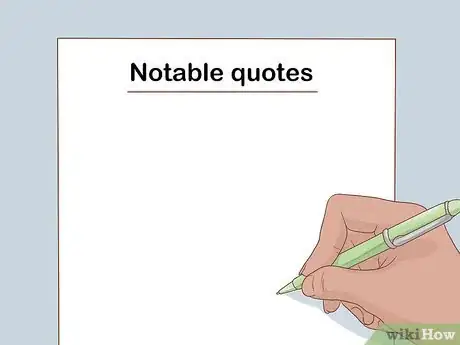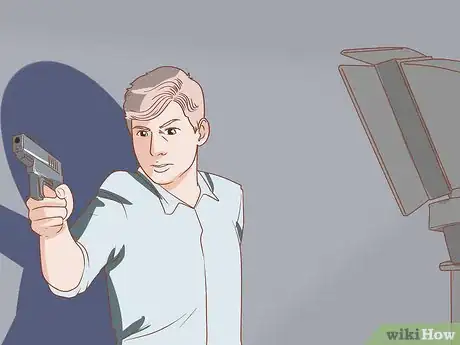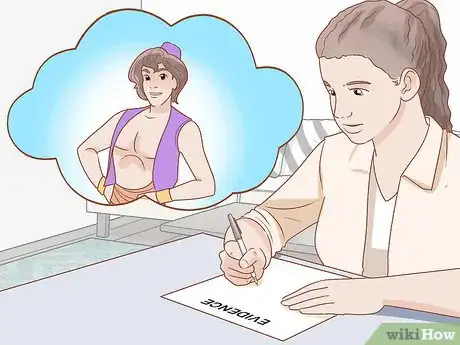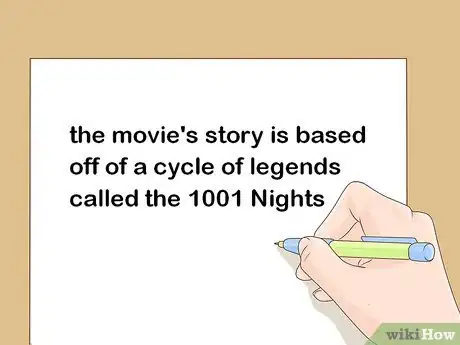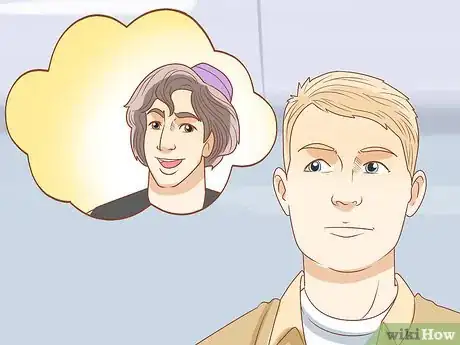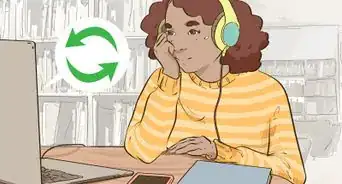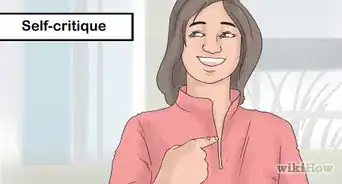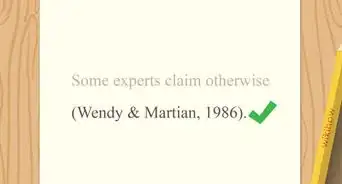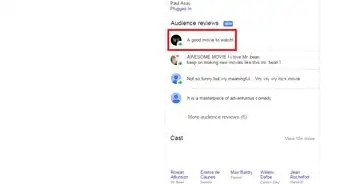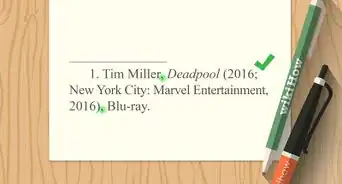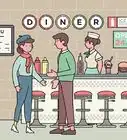This article was co-authored by Lucy V. Hay. Lucy V. Hay is a Professional Writer based in London, England. With over 20 years of industry experience, Lucy is an author, script editor, and award-winning blogger who helps other writers through writing workshops, courses, and her blog Bang2Write. Lucy is the producer of two British thrillers, and Bang2Write has appeared in the Top 100 round-ups for Writer’s Digest & The Write Life and is a UK Blog Awards Finalist and Feedspot’s #1 Screenwriting blog in the UK. She received a B.A. in Scriptwriting for Film & Television from Bournemouth University.
There are 19 references cited in this article, which can be found at the bottom of the page.
wikiHow marks an article as reader-approved once it receives enough positive feedback. In this case, 91% of readers who voted found the article helpful, earning it our reader-approved status.
This article has been viewed 262,505 times.
Movies are a wonderful medium for both entertainment and art, and examining them closely only enhances their magic. If you're writing a review for a newspaper or a paper for class, you’ll have to break down the elements of a film and explain what they mean to you. By watching carefully, probing all the aspects, and focusing on the themes that resonate with you, you will produce a thoughtful and sophisticated analysis.
Steps
Watching the Movie
-
1Know only the basics. If you’ve never seen the movie you want to analyze before, don’t do a ton of research beforehand. You want to go into the movie and let it make its impression on you, not the other way around. It’s good to know some very simple background information, but otherwise, try to let the film speak for itself.
- Some of the basics you will want to know include: the year and place the movie was made; the studio that sponsored it; and its director, main actors, and writers.
- Try to avoid reading reviews or spoilers before the movie; they can bias you.[1] Even trailers can make you judge a movie before you see it.
-
2Watch alone (or with a quiet friend). You are going to want to focus in-depth on the movie so that you can write a good analysis later, and it’s best to do that without any distractions. Some people find it intimidating to go to the movies alone, but you may find that's it's actually fun and helps you focus better on the things that matter.[2]
- If you feel like you must go with a friend, pick a thoughtful one. Someone who squirms or makes jokes all the time will distract you.
Advertisement -
3Watch all in one sitting. Unlike television shows, movies are meant to be seen all at once.[3] If you interrupt the flow of the movie to get a snack or run around the block, you won’t have the experience the creators intended you to have. Sit still, and hit pause as little as possible.
-
4Take a few notes. If you aren’t in a dark theatre, you can scribble down a few observations to yourself as the movie unfolds. However, your focus should be on the movie, not on your writing, so don’t get too caught up in doing an in-depth analysis right there in your seat. You can do that later! Make sure you don’t pause.[4] Some things you may want to jot down, especially if they catch your attention, include:
- Major plot points.
- Crucial or repeated lines.
- Particularly notable shots.
-
5Write down all your thoughts after. While the credits are rolling and your brain is still fresh, record everything that struck you about the movie or felt significant.[5] You don’t have to organize these thoughts into categories yet, so just make a point of focusing on things you thought were interesting, or emphasized by the filmmakers. If you’re stuck for ideas, try thinking about…
- ...the way color was used.
- ...whether the shots flowed together or were jarring.
- ...if particular characters or things were supposed to represent certain things.
-
6Wait, then look over your thoughts. After a day or so, review the notes you took during and after the movie. Think about if any of the things you focused on seemed to be bigger issues throughout the movie, from a theme of self-sacrifice to the fact that only evil characters wear hats. Once you’ve identified the themes that seem most important, you can start breaking down the movie to look for evidence in each of its elements.EXPERT TIPLucy V. Hay is a Professional Writer based in London, England. With over 20 years of industry experience, Lucy is an author, script editor, and award-winning blogger who helps other writers through writing workshops, courses, and her blog Bang2Write. Lucy is the producer of two British thrillers, and Bang2Write has appeared in the Top 100 round-ups for Writer’s Digest & The Write Life and is a UK Blog Awards Finalist and Feedspot’s #1 Screenwriting blog in the UK. She received a B.A. in Scriptwriting for Film & Television from Bournemouth University.Professional Movie Writer

 Lucy V. Hay
Lucy V. Hay
Professional Movie WriterOur Expert Agrees: After you've taken notes on the movie, leave it for a few days, then revisit them. Any strong emotions that you felt right after the movie have probably dissipated, and you might even feel the opposite from how you did right after the movie. Then, look over your notes and think about things like the craft of the film—things like how they brought different concepts, characters, and plots together, for instance. You can also look at the theme, the target audience, and whether the writing is good or bad—and why.
Breaking Down the Movie
-
1Investigate the movie’s background. Any given movie contains at least two stories: the narrative it tells, and the background of its creation. Movies take a lot of time, effort, and money to make. Learning a bit about how the film you’re trying to analyze was made will give you a lot of insight into it.
- Are there any myths about the movie’s creation? For example, The Wizard of Oz has a ton of urban legends surrounding it.[6] Even if the legends aren’t true, they may tell you about the movie’s mystique or fan base.
- Did the filmmakers intend for the movie to comment on contemporary politics or culture? For instance, Dr. Strangelove was made in the 1960s and satirized the Cold War that the United States was embroiled in.[7]
- Was the movie based on a true story, fiction, or a mix of the two? For example, the 1977 TV series Roots explores the family history of writer Alex Haley. Even though real people and events are present, the story is fleshed out with fictionalized characters and side events.[8]
-
2Think about the story arc. Movies are a storytelling medium, and the success of a film depends on the structure of the story. Think about the pacing of the story and whether it's choppy or smooth. Make note of any major plot twists, too.
- If you want to figure out if a movie was well-plotted, write down the major events of the plot as you remember them. If you can remember them in order, that’s a good sign.
- Most movie plots follow the same structure: setup, to new situation, to progress, to higher stakes, to final push, to resolution.[9]
-
3Engage with the writing. The writing of a movie supports the story, so a well-plotted movie is often well-written as well. Try to figure out if you got all the information you needed from the writing. Make a list of any notable quotes or phrases.
- Does the dialogue sound believable, like real people talking? Even in movies that take place in the past, you should not be so distracted by old-timey grammar that you can’t follow the story.
- Try to tell where the jokes are, and if they land well. (You can easily tell this in a theatre--if you hear other people laughing, it means the joke worked.)
- Make note of moments of silence. These can say as much as words do.
-
4Judge the acting. Think about the characters for a moment. Are they believable? This does not mean whether you like the character portrayed or not, but refers instead to whether the acting helped you to believe the characters were real. Just as important is an actor’s presence on the screen. If an actor commands your attention so that you can’t look away, they’re probably performing well.[10]
-
5Analyze the lighting and camera techniques. A horror movie might use a shaky camera and dim light to express authenticity. A blockbuster might rely on bright lighting that makes the actors look flawless, and smooth cuts from shot to shot. Try to identify the mood you get from looking at a particular scene, then identify the camera and lighting work that is making you feel that way. Angles are important too: they show you where the director would want you positioned in a scene. Does the angle make you feel like you’re looking down on people, or backed up into a corner?[13]
- Find your favorite scene in the movie and pause it on the screen. Then, pay attention to the lighting and composition—think about how it affects the atmosphere and emotion in that scene.[14]
-
6Consider the soundtrack. Movie soundtracks are an accessible way for all types of people to engage with music--even orchestral music! Think about the soundtrack's volume, mood, and importance to the plot. A good soundtrack will deepen the mood of the movie that you're watching and may even advance the plot. It should not be distracting.
- Horror movies are well-known for their atmospheric soundtracks, which can make a tense environment even scarier. The Shining is a famous example of this: with the music turned off, some of the most terrifying scenes don't seem so bad.
- Some period movies like A Knight’s Tale, or Sofia Coppola’s Marie Antoinette, use contemporary music to help audiences better empathize with historic figures.[15]
-
7Examine the trappings. The inanimate objects used to set the proper mood for a movie can tell you a lot about it too. Is the director of the movie known for a particular aesthetic? Do you feel a specific way when you look at the sets? Is this the type of movie in which the plot doesn’t matter because the accessories are so fabulous?
- Look at the costumes. Clothes are an easy way to set a movie in a particular time or place, but if they’re not accurate, they can detract from the film.[16] Examine the outfits the characters wear carefully, and try to figure out if they do any visual storytelling of their own.
- Sets are powerful too. Many films shoot for hyper-realistic sets, while others have more basic backdrops. Some directors even choose sets that look like theatre stages as a deliberate choice.[17]
Putting the Analysis Together
-
1Organize your evidence. You want facts that support your concept of its themes, which could be concepts, colors, or even repeated images or lines of dialogue throughout the film. Look over your thoughts on the different elements of the movie and see if you can find support for your thoughts.
- For instance, if you're analyzing the 1995 Disney movie Aladdin, you might think about how Aladdin craves both freedom (from hunger, prison, and poverty) and power throughout the movie, and how other characters' desires for freedom or power shape them as well. You might think about how Aladdin and Jasmine each describe themselves as "trapped" at first, despite their different circumstances, and how the Genie is happy to trade physical strength for a vacation at the end.
- Pick the themes that resonate with you. The best writing comes from enthusiasm, so channel what excites you into your work.
- Remember that directors don’t necessarily put themes in on purpose. For instance, many critics felt that objectification of women was a theme throughout Transformers, but it’s unlikely that the director consciously chose to do this.[18]
-
2Start with an introduction. Now that you’ve made all your judgements of the movie, it’s time to help others do the same. Mention the background of the film, including the people involved in making it, and make a note of any expectations you had going in. At this point, you can hint as to your theories about the movie, but there’s no need to hit your readers over the head with them.[19]
- In your analysis of Aladdin, you would want readers to know that the movie's story is based off of a cycle of legends called the 1001 Nights and that its images are inspired by an earlier, unfinished movie called The Thief and the Cobbler.[20]
-
3Summarize the plot. Take a sentence or three to explain the setup of the plot and the seeds of the major conflict. Try to be as brief as possible: plot is but one small aspect of the movie, and you have a lot of ground to cover.[21]
- To summarize Aladdin, you'd want to say that it's the story of a clever young man whose life changes forever when an encounter with a Genie grants him incredible power and privilege--though not without a cost.
- It should go without saying, but if you're writing a review, no spoilers. Don’t describe any major twists or resolutions.
- If you're writing a more formal analysis for class, it's okay to explain the whole plot.
- Don’t get too snarky. A joke or two is fine.
-
4Explore the themes you find interesting. Once you’ve gone into the bones of the movie, you can tell your reader about the layers on top of them. Pose a hypothesis about what you think the filmmaker is trying to say, or even what the filmmaker wants you to think. Identify examples of elements in the movie that prove your point.
- In the story of Aladdin, you could make the argument that power is a trap. Both Jasmine and the Sultan are royalty, but their lives are ruled by antiquated marriage laws and Jafar, a vizier who towers over both of them. Both Jafar and Aladdin use the Genie to gain great temporary control, but these new powers are capricious. Jafar is defeated by his power: he turns into a genie and is imprisoned in a lamp. By the end, Jasmine has been freed to marry who she wants, and Aladdin has chosen to free the Genie, as he promised. The characters who choose their own freedom--and prioritize others' freedom at the expense of their own power--are rewarded.
- You don’t have to tie all your observations back to a simple thesis, necessarily. However, it’s good to stay on task.
-
5Criticize aspects of the movie you did not appreciate. Don't be afraid to criticize. There are very few perfect films, and a nuanced discussion of the film’s flaws will add strength to your analysis. Go ahead and say what would you change about the movie. Are there any ways in which it could support its themes better?
-
6Wrap it up. Did the film meet expectations? What is your overall verdict? Use your opinion backed up by analysis and facts. Obviously, this is your review, and it can’t be objective: express whether you think the movie succeeded at its aims, and whether you enjoyed it.
- In the conclusion of your analysis of Aladdin, you might decide that its emphasis on the joys of freedom resonated with you and made the movie a popular hit, but you were troubled about how casual the protagonist was about making weaker or indentured characters (like the monkey, carpet, and Genie) do his work for him.
- Overall, do you think the movie was a success? Can you imagine the filmmakers exploring similar visions later?
- If you’re writing an accessible review for a large audience, feel free to make a recommendation about what types of people might be interested in the movie (costume fans, classical music buffs, people who like watching things blow up…)
Expert Q&A
Did you know you can get expert answers for this article?
Unlock expert answers by supporting wikiHow
-
QuestionWhat types of things should be considered when analyzing a film?
 Stephen CardoneStephen Cardone is the COO of NY Headshots, a New York City-based studio that specializes in shooting and producing headshots for individuals and businesses. Stephen has over four years of professional photography experience and over six years of documentary filmmaking experience. Stephen also works extensively as a photographer at NY Headshots. His work includes events, environmental photography, as well as headshots for actors, models, and corporate. He holds a BA in Non-fiction Writing from The New School.
Stephen CardoneStephen Cardone is the COO of NY Headshots, a New York City-based studio that specializes in shooting and producing headshots for individuals and businesses. Stephen has over four years of professional photography experience and over six years of documentary filmmaking experience. Stephen also works extensively as a photographer at NY Headshots. His work includes events, environmental photography, as well as headshots for actors, models, and corporate. He holds a BA in Non-fiction Writing from The New School.
Professional Photographer
-
QuestionWhat are the key elements of film analysis?
 Stephen CardoneStephen Cardone is the COO of NY Headshots, a New York City-based studio that specializes in shooting and producing headshots for individuals and businesses. Stephen has over four years of professional photography experience and over six years of documentary filmmaking experience. Stephen also works extensively as a photographer at NY Headshots. His work includes events, environmental photography, as well as headshots for actors, models, and corporate. He holds a BA in Non-fiction Writing from The New School.
Stephen CardoneStephen Cardone is the COO of NY Headshots, a New York City-based studio that specializes in shooting and producing headshots for individuals and businesses. Stephen has over four years of professional photography experience and over six years of documentary filmmaking experience. Stephen also works extensively as a photographer at NY Headshots. His work includes events, environmental photography, as well as headshots for actors, models, and corporate. He holds a BA in Non-fiction Writing from The New School.
Professional Photographer When you're studying a film, look at the cinematography, which is the use of lighting and the camera to create the images you see. There's also the script, which is the dialogue and, in some cases, notes about how the characters should move or deliver certain lines. You might also pay attention to the actors' performances, the editing, and the production of the film.
When you're studying a film, look at the cinematography, which is the use of lighting and the camera to create the images you see. There's also the script, which is the dialogue and, in some cases, notes about how the characters should move or deliver certain lines. You might also pay attention to the actors' performances, the editing, and the production of the film. -
QuestionWhat is the easiest way to do this?
 Julia PearseCommunity AnswerWatch the movie over and over until you know it inside and out. Make inferences during the movie and take note of important events that might affect a characters attitude. For example: In "Hacksaw Ridge," Desmond Doss swore to never touch a gun, because he almost shot his father when he was younger. That experience led him to think in another way that would keep him from making the same mistake.
Julia PearseCommunity AnswerWatch the movie over and over until you know it inside and out. Make inferences during the movie and take note of important events that might affect a characters attitude. For example: In "Hacksaw Ridge," Desmond Doss swore to never touch a gun, because he almost shot his father when he was younger. That experience led him to think in another way that would keep him from making the same mistake.
Warnings
- Don’t try to cram everything about a movie into one essay. It’s unnecessary--just focus on what you find important.⧼thumbs_response⧽
References
- ↑ http://www.sdfilmfest.com/how-to-analyze-a-movie-step-by-step-guide-to-reviewing-films-from-a-screeners-point-of-view/
- ↑ http://nymag.com/scienceofus/2015/04/why-you-should-go-to-the-movies-alone.html
- ↑ http://www.filmsite.org/filmview.html
- ↑ http://www.filmsite.org/filmview.html
- ↑ http://www.sdfilmfest.com/how-to-analyze-a-movie-step-by-step-guide-to-reviewing-films-from-a-screeners-point-of-view/
- ↑ https://www.buzzfeed.com/donnad/8-myths-about-the-wizard-of-oz
- ↑ http://www.newyorker.com/news/news-desk/almost-everything-in-dr-strangelove-was-true
- ↑ http://articles.chicagotribune.com/1993-03-10/news/9303190620_1_pulitzer-board-philip-nobile-roots
- ↑ http://www.movieoutline.com/articles/the-five-key-turning-points-of-all-successful-movie-scripts.html
- ↑ http://www.businessinsider.com/how-to-tell-good-acting-from-bad-acting-2014-9
- ↑ https://voicebunny.com/blog/how-to-learn-accents-and-dialects-like-a-champ/
- ↑ http://www.brazen.com/blog/archive/smart-hacks/7-body-language-rules-you-can-learn-from-a-legendary-dead-actor/
- ↑ https://www.videomaker.com/article/c10/1384-camera-work-shots-and-scenes
- ↑ Stephen Cardone. Professional Photographer. Expert Interview. 5 May 2020.
- ↑ http://www.rogerebert.com/reviews/marie-antoinette-2006
- ↑ http://www.frockflicks.com/snark-week-9-things-movies-get-wrong-16th-century-costume/
- ↑ http://www.nytimes.com/2012/11/16/movies/anna-karenina-from-by-joe-wright-with-keira-knightley.html?_r=0
- ↑ http://www.filminquiry.com/analyse-movies-introduction/
- ↑ http://www.crlsresearchguide.org/17_Writing_Introduction.asp
- ↑ http://mentalfloss.com/article/74031/13-beautiful-facts-about-thief-and-cobbler
- ↑ http://writingcenter.unc.edu/handouts/summary-using-it-wisely/
About This Article
To analyze a movie, start by introducing its background, along with any ideas you had about the film before you saw it. Then, briefly describe the movie’s major conflict, and summarize its plot. Next, talk about the themes you found interesting, and explain how the film supported those themes. You should also speak to what you didn’t like, or what wasn’t well done in the movie. Finally, give your overall assessment, backing up your opinion with the previous analysis, and providing any suggestions to others who might want to watch the film. For tips on how to analyze a movie’s cinematography, soundtrack, or acting, keep reading!
